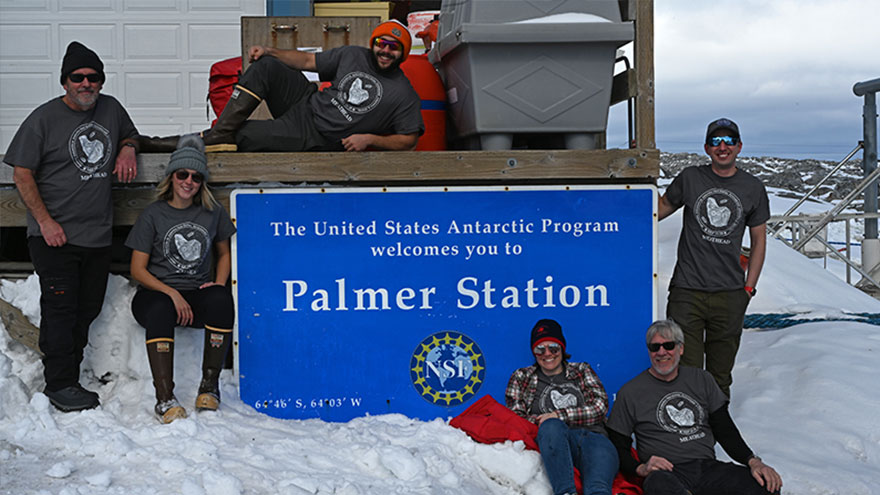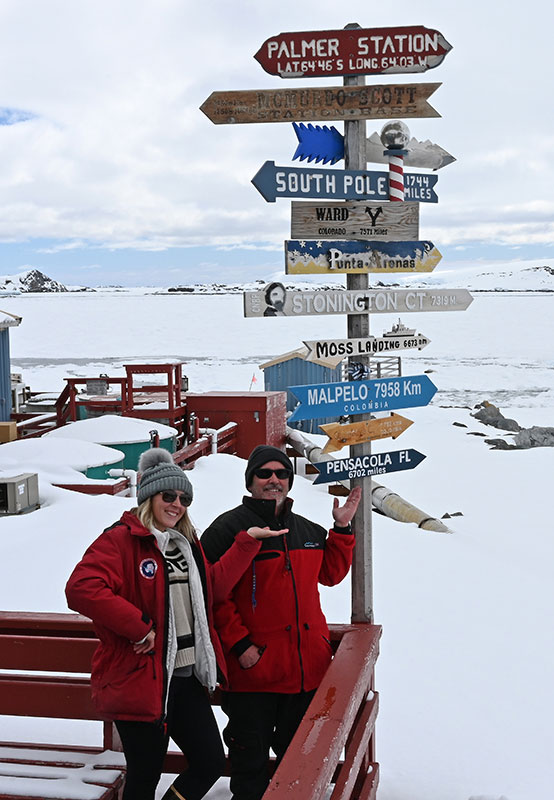A Quick Trip to Palmer Station
November 20, 2019 | Dr. Wade Jeffrey, Director of CEDB | wjeffrey@uwf.edu

After the installation of the radar station at the Wauermans Islands, we headed into Palmer Station the next morning. Palmer is one of three permanent US research stations in the Antarctic. It is the smallest of the three with a capacity below 40 people. There are two main buildings for scientists at Palmer Station – the Bio building where the labs are, the dining hall, and many of the dorm rooms. The other building called GWR has more dorms, the power plant, heavy mechanics garage, gym, bar, and store. The other two stations are McMurdo Station, which is located south of New Zealand, and has a population of about 1500 at its peak season and operates like a small town. South Pole station is located, well…. at the south pole with a population of about 250, and is only accessible by plane about 5 months out of the year…. Or walking/skiing across the continent (google the story of the first two guys to walk across unassisted earlier this year). I have been to McMurdo several times but never south pole (no ocean there… not much for an oceanographer to do…). Our objective for the day was to transfer 6 people off the ship who were going to work at the station before heading back home. We also had supplies, samples, and cargo that needed to be transferred as well as picking up some supplies and small equipment that we would use on the ship (for instance I borrowed a small centrifuge and a chemical I needed). This was all to be accomplished by using the small zodiac boats to go between our ship and the station. Unfortunately, the ice moved in overnight and was too heavy for zodiac operations. Our ship, the Nathaniel B Palmer (NBP) is too big to tie up directly to the Palmer Station pier (the ship draws too much water to pass over a pesky rock that sits at the end of the pier). However, the smaller ship - the Laurence M Gould can safely tie up to the station and was there when we arrived (see photo). Since zodiac operations were not possible, they tied up the NBP to the LMG. I was told that this is the first time they had done this since 2000. It presents some challenges – the NBP is about 100 feet longer than the LMG, and also higher. The solution was to secure a gangway between the 04 deck of the NBP to the bridge deck of the LMG. Here is a photo of one of the students walking between ships. Coming down the stairs on the LMG to the main deck took us through the galley – there was a strong temptation to help ourselves to the FROSTED Pop-Tarts on the LMG... But we behaved ourselves.
Once the gangway was secured, we were allowed off the ship to walk around the station. I gave an informal tour to the others in our group since I have visited Palmer Station several times and worked there for 6 weeks 20 years ago. Besides seeing the labs and recreational areas, the most important thing was to go to the station store to buy Antarctic swag (Palmer station T-shirts, jackets, stickers, magnets, etc). Spoiler alert - I’ll wager a lot of Christmas shopping was done. We also stopped in at the galley for some fresh, homemade hot chocolate. The most important thing, however, was to install the Pensacola arrow on the pole with all of the other directional signs. Here’s a photo of me and my graduate student, Leila Harris, finding our way home. We also took collective group shots of our group in front of the station sign and the fuel tank. Finally, the presence of both ships made a great opportunity for a “hero shot” with both ships.

Palmer sits on Anvers Island. There is Hero Inlet in front of the station on the right (named after the old wooden research vessel HERO used until the ’80s. To the left is the larger Arthur Harbor which ends at the glacier. The most remarkable thing about the change in Palmer station is the receding glacier behind it... In 1999 it came down just behind the station, now it's way up the hill. There is now an area referred to as the station “backyard” which didn’t exist when I worked there. While standing in the back of the station looking at the glacier we could hear it cracking and changing. We didn’t see any break-offs, but we sure heard a lot! One real obvious evidence of the change in the glacier is that now you can see Dietrich Island as a stand-alone piece of land – until a few years ago it was covered by the glacier.
We were back aboard the NBP by dinner and left at 8 pm. We started our transit south toward Marguerite Bay. The ice is heavy and the going is slow (more than once we have had to use the “back and ram” method to break through heavier ice. But the ship is now dedicated to our project and the sea ice team and we are excited to get into our routine.







